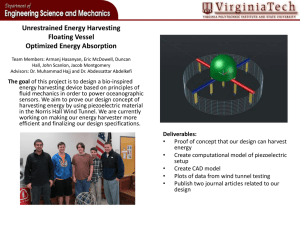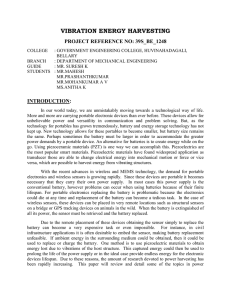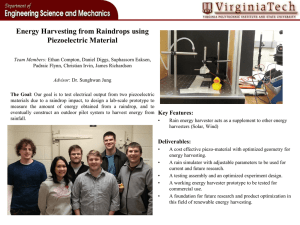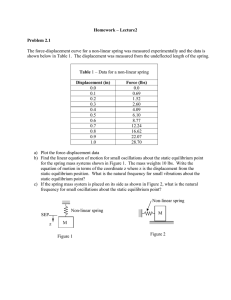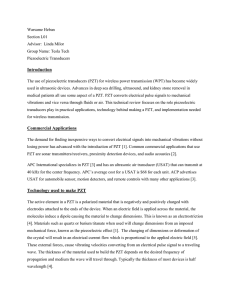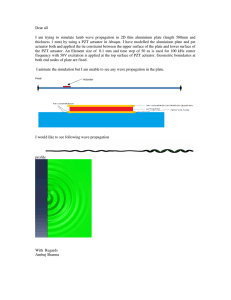Estimation of Electric Charge Output for Piezoelectric Energy
advertisement
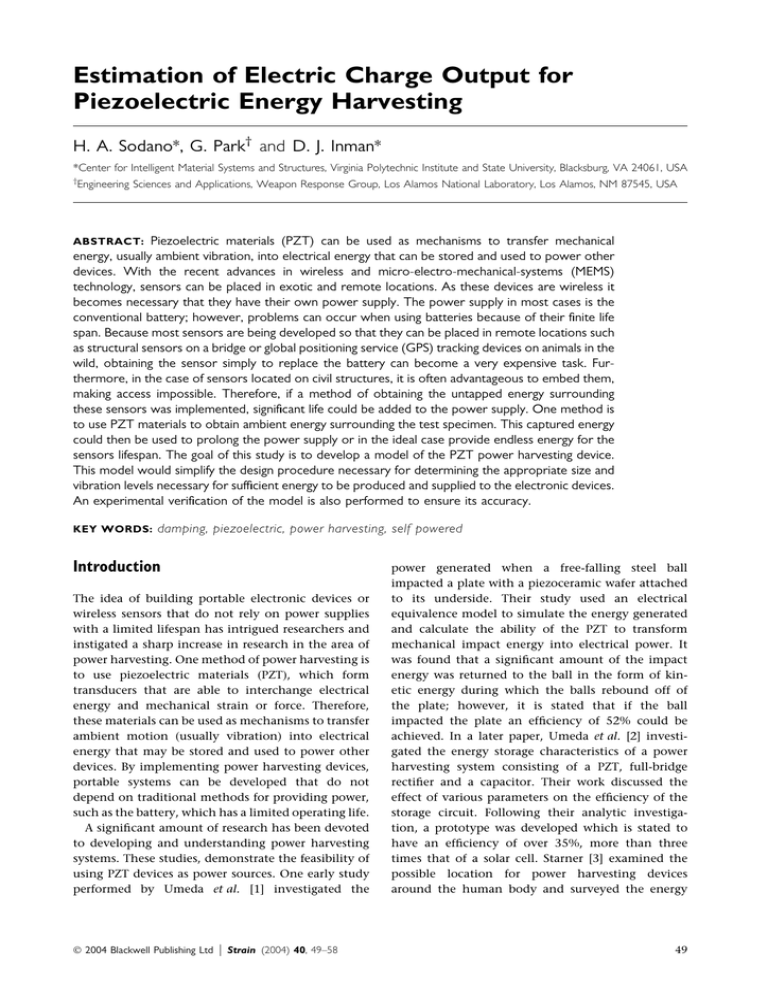
Estimation of Electric Charge Output for Piezoelectric Energy Harvesting H. A. Sodano*, G. Park† and D. J. Inman* *Center for Intelligent Material Systems and Structures, Virginia Polytechnic Institute and State University, Blacksburg, VA 24061, USA † Engineering Sciences and Applications, Weapon Response Group, Los Alamos National Laboratory, Los Alamos, NM 87545, USA Piezoelectric materials (PZT) can be used as mechanisms to transfer mechanical energy, usually ambient vibration, into electrical energy that can be stored and used to power other devices. With the recent advances in wireless and micro-electro-mechanical-systems (MEMS) technology, sensors can be placed in exotic and remote locations. As these devices are wireless it becomes necessary that they have their own power supply. The power supply in most cases is the conventional battery; however, problems can occur when using batteries because of their finite life span. Because most sensors are being developed so that they can be placed in remote locations such as structural sensors on a bridge or global positioning service (GPS) tracking devices on animals in the wild, obtaining the sensor simply to replace the battery can become a very expensive task. Furthermore, in the case of sensors located on civil structures, it is often advantageous to embed them, making access impossible. Therefore, if a method of obtaining the untapped energy surrounding these sensors was implemented, significant life could be added to the power supply. One method is to use PZT materials to obtain ambient energy surrounding the test specimen. This captured energy could then be used to prolong the power supply or in the ideal case provide endless energy for the sensors lifespan. The goal of this study is to develop a model of the PZT power harvesting device. This model would simplify the design procedure necessary for determining the appropriate size and vibration levels necessary for sufficient energy to be produced and supplied to the electronic devices. An experimental verification of the model is also performed to ensure its accuracy. ABSTRACT: KEY WORDS: damping, piezoelectric, power harvesting, self powered Introduction The idea of building portable electronic devices or wireless sensors that do not rely on power supplies with a limited lifespan has intrigued researchers and instigated a sharp increase in research in the area of power harvesting. One method of power harvesting is to use piezoelectric materials (PZT), which form transducers that are able to interchange electrical energy and mechanical strain or force. Therefore, these materials can be used as mechanisms to transfer ambient motion (usually vibration) into electrical energy that may be stored and used to power other devices. By implementing power harvesting devices, portable systems can be developed that do not depend on traditional methods for providing power, such as the battery, which has a limited operating life. A significant amount of research has been devoted to developing and understanding power harvesting systems. These studies, demonstrate the feasibility of using PZT devices as power sources. One early study performed by Umeda et al. [1] investigated the 2004 Blackwell Publishing Ltd j Strain (2004) 40, 49–58 power generated when a free-falling steel ball impacted a plate with a piezoceramic wafer attached to its underside. Their study used an electrical equivalence model to simulate the energy generated and calculate the ability of the PZT to transform mechanical impact energy into electrical power. It was found that a significant amount of the impact energy was returned to the ball in the form of kinetic energy during which the balls rebound off of the plate; however, it is stated that if the ball impacted the plate an efficiency of 52% could be achieved. In a later paper, Umeda et al. [2] investigated the energy storage characteristics of a power harvesting system consisting of a PZT, full-bridge rectifier and a capacitor. Their work discussed the effect of various parameters on the efficiency of the storage circuit. Following their analytic investigation, a prototype was developed which is stated to have an efficiency of over 35%, more than three times that of a solar cell. Starner [3] examined the possible location for power harvesting devices around the human body and surveyed the energy 49 Estimation of Electric Charge Output for Piezoelectric Energy Harvesting : H. A. Sodano, D. J. Inman and G. Park available from sources of mechanical energy including blood pressure, walking, and upper limb motion of a human being. The author claims that 8.4 W of useable power can be achieved from a PZT mounted in a shoe. Kymissis et al. [4] examined using a piezofilm in addition to a Thunder actuator [5, 6], to charge a capacitor and power a radio frequency identification (RFID) transmitter from the energy lost to the shoe during walking. The polyvinylidene fluoride (PVDF) stave was located in the sole to absorb the bending energy of the shoe, and the piezoceramic thunder actuator was located in the heel to harvest the impact energy. Their work showed that the power generated by the PZT devices was sufficient for powering functional wireless devices and were able to transmit a 12-bit signal five to six times every few seconds. Following the work of Kymssis et al. [4], the research involving wireless sensors began to grow, and in 1998, Kimura [7] received a US Patent that centered on the use of a vibrating PZT plate to generate energy sufficient to run a small transmitter fixed to migratory birds for the purpose of transmitting their identification code and location. The effectiveness of the power harvesting system is also compared with existing battery technology. Goldfarb and Jones [8] presented a linearised model of a PZT stack and analysed its efficiency as a power generation device. It was shown that the maximum efficiency occurs in a low frequency region, much lower than the structural resonance of the stack. It is also stated that the efficiency is also related to the amplitude of the input force due to hysteresis of the PZT. In addition to the force applied in the poling direction (d33 mode), Clark and Ramsay [9] have investigated and compared it with the transverse force (d31 mode) for a PZT generator. Their work showed that the d31 mode has a mechanical advantage in converting applied pressure to working stress for power generation. They concluded that a 1-cm2 piezoceramic wafer can power a MEMS device in the microwatt range. Elvin et al. [10] theoretically and experimentally investigated a self-powered wireless sensors using PVDF. The power harvesting system used the energy generated by the PVDF to charge a capacitor and power a transmitter that could send information regarding the strain of the beam, a distance of 2 m. Kasyap et al. [11] formulated a lumped element model to represent the dynamic behaviour of PZT in multiple energy domains using an equivalent circuit. Additionally, this work dealt with the construction of a flyback converter which allows the circuit’s impedance to be adjusted to match that of the PZT material. This concept of matching the 50 impedance of the PZT and the load maximises the power flow from the PZT. Their model was experimentally verified using a 1-D beam structure with peak power efficiencies of c. 20%. Most of the previous studies found out that the energy generated by the PZT material must be accumulated before it can be used to power other electronic devices. Rather than use the traditional capacitor that most other studies used, Sodano et al. [12] investigated the use of rechargeable batteries to accumulate the generated energy. The goal of this study was to show that the small amounts of ambient vibration found on a typical system could be used to charge the battery from its discharged state and demonstrated the compatibility of rechargeable batteries and the power generated by PZT materials. To do this, the vibration of the air compressor of a typical automobile was measured and a similar signal was applied to an aluminum plate with a PZT patch attached. It was found that the random signal from the engine compartment of a car could charge the battery in only a couple of hours and that a resonant signal could charge the battery in under an hour. Ottman et al. [13] found out that if circuitry was used to maximise the energy generated then these storage devices could be charged with greater efficiency. Therefore, they investigated the effects of utilising a DC–DC stepdown converter with an adaptive control algorithm to maximise the power output of the PZT material. They found out that when using the adaptive circuit, energy was harvested at over four times the rate of direct charging without a converter. This study concentrates on developing an analytic model of a beam with attached PZT elements that will provide an accurate estimate of the power generated through the PZT effect. It has been found in previous studies that PZT material attached to a beam with cantilever boundary conditions provides an effective configuration for capturing transverse vibrations and converting them into useful electrical power. This configuration has proven to be effective in several experiments carried out by Sodano et al. [12, 14]. The model detailed in this paper is based on a more general one developed by Hagood et al. [15] to estimate the performance of PZT shunt damping circuits for passive vibration control. In addition, the model developed by Crawley et al. [16] was used to develop the actuation equations for PZT devices and the constitutive equations of bimorph actuators were obtained from Smits et al. [17]. However, an important addition is made to the combination of these models to accommodate power harvesting, which was neglected in the previous models, was to add material 2004 Blackwell Publishing Ltd j Strain (2004) 40, 49–58 H. A. Sodano, D. J. Inman and G. Park : Estimation of Electric Charge Output for Piezoelectric Energy Harvesting damping; if excluded, the model can predict significantly more energy generation that actually developed in the real system. The following sections describe the development of a model of the PZT power harvesting device. This model would simplify the design necessary for determining the appropriate size and extent of vibration needed for sufficient energy to be produced and supplied to the desired electronic devices. An experimental verification of the model is also performed to ensure its accuracy. Following the verification of the model, the effects of power harvesting on the dynamics of a structure are compared with those brought on from shunt damping. e ¼ dij cE Model of Piezoelectric Power Harvesting Beam The following derivation uses energy methods to develop the constitutive equations of a bimorph PZT cantilever beam for power harvesting. To begin the deviation we will start with the general form of Hamilton’s principle. This states that the variational indicator (VI) must be zero all the time, as shown below in Equation (1): Z t2 ½dT dU þ f dxdt ¼ 0 (1) VI ¼ t1 where T, U and fdx terms are defined by: Z Z Z 1 1 U¼ ST T dVs þ ST T dVp ET D dVp 2 Vs 2 Vp Vp T¼ 1 2 f dx ¼ Z Vs nf X i¼1 qs u_ T u_ dVs þ 1 2 Z duðxi Þ fi ðxi Þ Vp qs u_ T u_ dVp nq X where c is the modulus of elasticity, e is the dielectric constant and the superscript, ()S, signifies that the parameter was measured at constant strain and the superscript, ()E, indicates that the parameter was measured at constant electric field (short circuit). These constitutive equations relate the electrical and mechanical properties of the PZT element. The specification of these relationships allow electromechanical interaction to be included in the model. The term e is the PZT coupling coefficient and relates the stress to the applied electric field. The PZT coupling coefficient can be written as shown in Equation 6 in terms of the more commonly specified coupling coefficient d by: (2) where c is the modulus of elasticity and dij is the PZT coupling coefficient with the subscripts ‘i’ and ‘j’ referring to the direction of the applied field and the poling, respectively. Now we can incorporate the PZT properties in the potential energy function: U¼ 1 2 Vs Z j Strain (2004) 40, 49–58 ST cE S dVp: Vp ET eS dVp Z Z ST eT E dVp Vp ET eS E dVp (7) Vp Taking the variation of the kinetic energy from Equation 3, and the potential energy term containing the PZT properties of Equation 7, yields: dU ¼ Z T dS cs S dVs þ Z Vs (3) T E dS c S dVp Vp Z dE eS dVp dT ¼ Z Vs Z dST eT E dVp Vp Z T Vp (4) where U is the potential energy, T is the kinetic energy, fdx is the external work applied to the system, and superscripts S, T and E representing the strain, stress, and electric field, respectively, D the electric displacement, V the volume, u the displacement, x the position along the beam, v the applied voltage, q the charge, q the density, f the applied force and the subscripts ‘p’ and ‘s’, represent the PZT material and the substrate, respectively. Before the variational indicator can be used to solve for the equations of motion, the PZT constitutive equations need to be introduced into the potential energy term and the variation of both the potential and kinetic energy must be found. First the PZT constitutive equations will be introduced, which are: E T S c eT ¼ (5) D E e eS Z ST cs S dVs þ Vp j¼1 2004 Blackwell Publishing Ltd Z dv qj (6) dET eS E dVp (8) Vp qs du_ T u_ dVs þ Z qp du_ T u_ dVp Vp (9) The variations found in Equations 4, 8 and 9 can be substituted into Equation 1 to obtain the variational indicator: Z t 2 Z Z VI ¼ qs du_ T u_ dVs þ qp du_ T u_ dVp : t1 þ Vs Z Z dST cs S dVs Vp Z Vs dST cE S dVp Vp dST eT E dVp þ Z Vp þ nf X i¼1 dET eS dVp þ Vp duðxi Þ f ðxi Þ nq X Z dET eS E dVp Vp dv qj (10) j¼1 This equation can now be used to solve for the equations of motion of any mechanical system containing PZT elements. In order to solve 51 Estimation of Electric Charge Output for Piezoelectric Energy Harvesting : H. A. Sodano, D. J. Inman and G. Park Equation 10 for the cantilever beam with bimorph PZT elements, some assumptions must be made. The first assumption follows the Rayleigh–Ritz procedure, which says that the displacement of the beam can be written as the summation of modes in the beam and a temporal coordinate [18]: uðx; t Þ ¼ N X /i ðxÞri ðt Þ ¼ /ðxÞr ðt Þ (11) i¼1 where /i(x) is the assumed mode shapes of the structure which can be set to satisfy any combination of boundary conditions, r(t) is the temporal coordinate of the displacement and N is the number of modes to be included in the analysis. The second assumption made is to apply the Euler–Bernoulli beam theory. This allows the strain in the beam to be the product of the distance from the neutral axis and the second derivative of displacement with respect to the position along the beam. Once the strain is defined in this way Equation 11 can be used define the strain as follows: S ¼ y @ 2 uðu; t Þ ¼ y/ðxÞ00 ðt Þ @x2 (12) The third and last assumption is that the electric potential across the PZT element is constant. This assumption also indicates that no field is applied to the beam, which in latter equations designates the beam to be inactive material: 8 < v=tp 0 E ¼ wðy Þvðt Þ ¼ : v=tp t=2 < y < t=2 þ tp t=2 < y < t=2 t=2 tp < y < t=2 (13) where w(y) defines the field over the thickness of the PZT, which is assumed to be constant. The previous assumption is for a beam with bimorph PZT elements on the top and bottom of the beam as shown in Figure 1. The beam in Figure 1 also shows the notation for the geometry of the beam that is used throughout the derivation. Using the previous assumptions we can simplify the variational indicator to include terms that represent physical parameters. By doing this, the equations describing the system become more recognisable when compared with those of a typical system and help give physical meaning to the parameters in the equations of motion. The mass matrices for the system can be written as: Z Ms ¼ qs /T ðxÞ/ðxÞdVs Vs Z (14) Mp ¼ qp /T ðxÞ/ðxÞdVp Vp The stiffness matrices can be written as: 52 Figure 1: Schematic of beam describing the variables Ks ¼ Z T y 2 / ðxÞ00 cs /ðxÞ00 dVs Vs Kp ¼ Z (15) T y2 / ðxÞ00 cE /ðxÞ00 dVp Vp The electromechanical coupling matrix, Q, and the capacitance matrix, Cp, are defined by: Z H¼ y/T ðxÞ00 eT wðyÞdVp Cp ¼ Vp Z (16) wT ðy ÞeS wðy ÞdVp Vp The parameters defined in Equations 14, 15 and 16 can be substituted into variational indicator of Equation 10. This substitution allows the variational indicator to be written as: VI ¼ Z t2 h dr_ T ðt Þ Ms þ Mp r_ ðt Þ dr T ðt Þ Ks þ Kp r ðt Þ t1 þ dr T ðt Þhvðt Þ þ dv ðt ÞHT r ðt Þ þ dv ðt ÞCp vðt Þ nf nq i X X dr ðt Þ/ðxi ÞT fi ðt Þ dvqj ðt Þ dt ¼ 0 þ i¼1 (17) j¼1 where d(Æ) indicates the variation of the corresponding variable. Taking the integral of the variational indicator leaves two coupled equations. The two equations shown below are coupled by the previously defined electromechanical coupling matrix Q. The first equation defines the mechanical motion and the second equation defines the electrical properties of the system: nf X Ms þMp €r ðt Þþ Ks þKp r ðt ÞHvðt Þ¼ /ðxi ÞT fi ðt Þ i¼1 (18) HT r ðt ÞþCp vðt Þ¼qðt Þ These equations now represent the electro-mechanical system and can be used to determine the motion of the beam, however this system of equations does not contain any energy dissipation. Because the model is intended to represent a power harvesting 2004 Blackwell Publishing Ltd j Strain (2004) 40, 49–58 H. A. Sodano, D. J. Inman and G. Park : Estimation of Electric Charge Output for Piezoelectric Energy Harvesting system that must be removing energy, this form is not suitable for our needs, as it does not account for energy lost through the structure. In addition, the energy removed from the system through energy harvesting must be accounted for. To incorporate energy dissipation into the equation one can use Ohm’s law and add a resistive element between the positive and negative electrodes of the PZT. The resistive element will provide a means of removing energy from the system. Then electrical boundary condition becomes: vi ðt Þ ¼ Rq_ ðt Þ (19) In addition, the system should have some type of additional mechanical damping that needs to be accounted for. If only the electrical damping is accounted for, the model will over predict the actual amount of power generated. The amount of mechanical damping added to the model was determined from experimental results. This is done using proportional damping methods and the damping ratio that is predicted from the measured frequency response function. With the damping ratio known, proportional damping can be found from [18]: C ¼ a Ms þ Mp þ b Ks þ Kp (20) where a and b are determined from: fi ¼ a bxi þ 2 2xi i ¼ 1; 2; . . . ; n (21) where fi is the damping ratio found from the frequency response of the structure. Incorporating Equations 19 and 20 into Equation 18, results in the final model of the power harvesting system: Ms þ Mp €r ðt Þ þ Cr_ ðt Þ þ Ks þ Kp r ðt Þ HC1 p qð t Þ ¼ nf X / ð xi Þ T f i ð t Þ through its own inertia. The standard boundary conditions of the clamped end of the beam say that the slope and displacement are zero at all time. For the condition of base motion, the zero displacement condition would not be held and a new set of mode shapes would need to be generated. Rather than doing this, it was decided that a force corresponding to the inertia of the beam when subjected to the base motion could be used and the clamped-free mode shapes would still be valid. The forcing function used to model the inertia of the beam is: f ðt Þ ¼ Z L 0 Z b 0 Z t qAx2 sinðxt Þ dz dy dx (23) 0 With the forcing function defined, everything necessary to simulate the power harvesting system has been included in the model. The following sections of this paper will describe the experimental procedures and results, in order to demonstrate the accuracy of this model. Experimental Setup for Model Verification The accuracy of the model will be tested on a Quick Pack model QP40N (Midé Technology Corporation, Medford, MA, USA), although it could be used to model any beam with attached PZT. The QP40N is a bimorph actuator with dimensions and properties shown in Figure 2. The Quick Pack actuator is constructed from four piezoceramic wafers embedding in a Kapton and epoxy matrix. Experiments were performed to verify the accuracy of the models ability to predict the amount of power generated from this device when subjected to transverse vibrations of varying frequency and amplitude. As mentioned (22) i¼1 T 1 Rq_ ðt Þ C1 p H r ðt Þ þ Cp qðt Þ ¼ 0: Equation 22 provides an accurate model of the power harvesting system. The q_ ðt Þ term provides the current output of the PZT element and can be directly related to the power output of the PZT through the load resistance R. The last portion of our model left undefined is the forcing function. The system that will be investigated is a cantilever beam that is excited by transverse vibrations of the structure that it is clamped to; therefore, no force is directly applied to the beam. Instead the clamped end of the beam is experiencing base motion and transferring that energy to the beam 2004 Blackwell Publishing Ltd j Strain (2004) 40, 49–58 Device size (mm): 100.6 × 25.4 × 0.762 Device weight (g): 9.52 Active elements: two stacks of two piezos Piezo wafer size (mm): 45.974 × 20.574 × 0.254 Full-scale voltage range (V): ±200 Figure 2: Midé Technology Corporation Quick Pack model QP40N (from Midé Technology Corporation) 53 Estimation of Electric Charge Output for Piezoelectric Energy Harvesting : H. A. Sodano, D. J. Inman and G. Park Table 1: Properties of the Quick Pack Property Figure 3: Quick Pack QP40N attached to the shaker and dimensions of beam when one end is clamped previously we were interested in the Quick Pack being mounted with cantilever boundary conditions. To provide the transverse vibration, the Quick Pack was mounted actuator to an electromagnetic shaker as shown in Figure 3. One complication that arose when modelling the Quick Pack actuator was due to its composite structure and the PZT wafers not spanning the entire length of the beam, which can be seen in Figure 2. Because the area of the beam with no PZT wafer consisted of only Kapton and epoxy, it contained a localised area with a lower modulus of elasticity. The manufacturer did not specify a value for the effective modulus of the complete beam. Therefore, the setup shown in Figure 4 was constructed to measure the stiffness of the Quick Pack. To obtain a value for the stiffness the force applied to the beam and its Symbol Value 1800 Dielectric constant k3T Piezoelectric strain coefficient d13 )179 · 10)12mV)1 Modulus of piezoelectric cE 63 GPa Modulus of Kapton–epoxy Modulus of Quick Pack cs cb 2.5 Gpa 35.17 GPa Density of piezo material q 7700 kg m)3 Density composite matrix q 2150 kg m)3 corresponding deflection needed to be measured. The experimental setup consists of a Transducer Techniques 100 gram load cell model GSO-100C and a Polytec laser vibrometer. The load cell was mounted on a lead screw to allow a steady force to be applied at the tip of the beam. The results of this test found the modulus of the beam to be 2.5 GPa. The reason for this value being so low is due to the area at the midspan of the beam that consisted of only the Kapton and epoxy. When the static tests were performed on the beam it was apparent that the majority of the bending was occurring at this location. Therefore, it was concluded that the experimental tests performed had actually measured the modulus of elasticity corresponding to the Kapton and epoxy portion of the beam. This still left the overall modulus of the beam unknown. The value calculated for the overall the modulus of the beam was found by simply averaging the modulus of the PZT material, that was supplied by the manufacturer and the experimentally found modulus for the Kapton and epoxy matrix according to their individual per cent of the cross sectional area. The resulting modulus of elasticity and the other PZT properties used are shown in Table 1. Model Verification The accuracy of the model was compared against experimental results to demonstrate the ability of the model to accurately predict the amount of power produced by the Quick Pack when subjected to transverse vibration. To ensure that the model and experimental tests were subjected to the same excitation force an accelerometer was used to calculate the amplitude of the sinusoidal force applied to the beam through: a ¼ Ax2 sinðxt Þ ) Amax ¼ Figure 4: Experimental setup used to find the elastic modulus of the Kapton–epoxy matrix 54 a x2 (24) where a is the acceleration of the clamped end of the beam. The beam was excited by a sinusoidal input and the steady state power output was measured across 2004 Blackwell Publishing Ltd j Strain (2004) 40, 49–58 H. A. Sodano, D. J. Inman and G. Park : Estimation of Electric Charge Output for Piezoelectric Energy Harvesting 0.05 –20 Predicted Measured Model Experimental 0.04 –40 0.03 0.02 Current (mA) Mode shapes –60 –80 –100 0.01 0 –0.01 –0.02 –120 –0.03 –140 –0.04 –160 0 200 400 600 800 1000 –0.05 1200 0 0.2 0.4 0.6 0.8 1 1.2 1.4 1.6 Time (s) Frequency (Hz) Figure 5: Frequency response of the model and the experimental data Figure 7: Output current predicted by model and measured several different resistors. The frequency response of the model and the experimentally tested Quick Pack are shown in Figure 5. The differences in the two responses are attributed to the Quick Pack’s composite structure resulting in coupled modes and the nonlinear properties of the Kapton material, especially its modulus of elasticity that varies nonlinearly with frequency. Additionally, looking at the mode shapes of a cantilever beam shown in Figure 6, it can be seen that in the second mode a large amount of bending occurs at the beam’s midsection. However the Quick Pack has an area of low stiffness at the midsection but because of the use of a uniform modulus of elasticity and density in the model, the stiffness is increased at this location and the predicted frequency of the second mode is higher than measured. It is expected that a beam constructed of a homogeneous material with a PZT mounted to is surface would produce a more accurate frequency response. The measured current generated by the Quick Pack was compared to the predicted current from the model for various frequencies and load resistances. The output current across a 100 kX resistor for an excitation frequency of 25 Hz of the model and the measured current obtained through experiments are shown in Figure 7. The predicted response shown in these figures shows a transient response for a small period of time while the experimental results do not because they were recorded at steady state vibration. Table 2 provides an approximate list of the measured and predicted currents generated for numerous values of frequency and load resistance. The values in this table demonstrate that the model provides a very accurate measurement of the power generated at various frequencies and resistive loads. This shows that the model would be effective as a design tool for determining the ideal size and excitation level necessary to provide the desired power. Normalized displacement 1 across a 100-kX resistor at 25 Hz Table 2: Amplitude of measured and simulated current First mode Second mode Third mode Frequency (Hz) 0.5 0 –0.5 –1 0 0.2 0.4 0.6 0.8 x/1 1 Load resistance (X) Simulated current (mA) Measured current (mA) Percent error 25 100 0.101 0.104 2.97 25 25 10 000 100 000 0.105 0.032 0.106 0.032 0.95 0.00 30 100 0.360 0.345 4.17 30 10 000 0.295 0.30 1.67 30 100 000 0.065 0.068 4.61 50 100 0.20 0.20 0.00 50 10 000 0.175 0.180 2.86 50 100 000 0.033 0.032 3.03 75 150 10 000 10 000 0.142 0.0132 0.144 0.0133 1.41 0.75 Figure 6: First three mode shapes of a cantilever beam 2004 Blackwell Publishing Ltd j Strain (2004) 40, 49–58 55 Estimation of Electric Charge Output for Piezoelectric Energy Harvesting : H. A. Sodano, D. J. Inman and G. Park Discussion of Power Harvesting and Shunt Damping 0.1 System: SYS Setting time (s): 0.945 0.08 0.06 0.1 0.08 0.06 100 Ω resistance Amplitude 0.04 0.02 0 –0.02 –0.04 System: SYS Setting time (s): 1.6 –0.06 –0.08 0 0.2 0.4 0.6 0.8 1 1.2 1.4 Time (s) Figure 8: Impulse response with a 100-X resistive load 56 1.6 Amplitude 0.04 15 kΩ resistance 0.02 0 –0.02 –0.04 –0.06 –0.08 0 0.2 0.4 0.6 0.8 1 1.2 1.4 1.6 Time (s) Figure 9: Impulse response with a 15-kX resistive load 0.08 System: SYS Setting time (s): 1.35 0.06 0.04 100 kΩ resistance Amplitude In addition to providing an accurate estimate of the power generated by a beam with a complicated PZT layout and a non-homogeneous material composition, the model also demonstrates that power harvesting works much like a shunt damper. When a power harvesting system is implemented, energy is removed from the system and supplied to the desired electrical components. As a result of the removal of energy from the system conservation of energy says that increased damping must occur. This is the same principle as that used in shunt damping systems. However, when implementing shunt circuits it is often advantageous to use a resistor, inductor and capacity (RLC) circuit that allows the circuit to be tuned to the resonant frequency of the system for maximum power dissipation. In the case of the power harvesting system that has been investigated in this paper, a constant load resistance was used which will also induce damping into the system but over a broad range of frequencies rather than the turned frequency of a RLC circuit. Only a load resistance has been used in this study due to the ability to match the impedance of the circuit or load and the PZT using circuitry such as a flyback converter discussed in the paper by Kasyap et al. [11]. The damping effect caused by power harvesting on the impulse response of a beam for three different load resistances is shown in Figures 8–10. In Figure 8 the load resistance is set at a low value of 100 X, which does not dissipate a large amount of energy, causing only a small amount of damping to be added to the system. In the case of Figure 9, the load resistance is set at an ideal value of 15 kX allowing the maximum flow of energy from the PZT device and, in turn, causing higher damping that is 0.02 0 –0.02 –0.04 –0.06 –0.08 0 0.2 0.4 0.6 0.8 1 1.2 1.4 1.6 Time (s) Figure 10: Impulse response with a 100-kX resistive load apparent in the increased settling time of the response. Now Figure 10 shows that the load resistance is further increased to 100 kX, giving the system the ability to dissipate a large amount of energy from the system. However, when the load resistance becomes very high, the ability of energy to flow from the PZT material is reduced causing the damping induced in the system to decrease. These figures demonstrate the effect of power harvesting on the dynamics of a structure. It is apparent that as more energy is removed from the system the impulse dies out faster until a critical level is reached, after which the resistive load of the circuit exceeds the impedance of the PZT network causing lower efficiency power generation and for this example lower energy dissipation to the beam. The critical resistance at which the most efficient energy is generated occurs when the load resistance is matched with the impedance of the PZT device. Therefore, the use of a flyback converter or other circuitry to tune the load resistance is a necessity in order to maximise the energy removed from the system. This study shows 2004 Blackwell Publishing Ltd j Strain (2004) 40, 49–58 H. A. Sodano, D. J. Inman and G. Park : Estimation of Electric Charge Output for Piezoelectric Energy Harvesting that the effects of power harvesting on the dynamics of a mechanical system are very similar to those of shunt damping, with the major difference being that the energy is stored for use rather than of dissipated. 1. Umeda, M., Nakamura, K. and Ueha, S. (1996) Analysis of transformation of mechanical impact energy to electrical energy using a piezoelectric vibrator. Japanese Journal of Applied Physics 35, 3267–3273. 2. Umeda, M., Nakamura, K. and Ueha, S. (1997) Energy storage characteristics of a piezo-generator using impact induced vibration. Japanese Journal of Applied Physics 36, 3146–3151. Conclusions One method of performing power harvesting is to use PZT materials that can convert the ambient vibration energy surrounding them into electrical energy. This electrical energy can then be used to power other devices or stored for later use. This technology has gained an increasing attention due to the recent advances in wireless and MEMS technology, allowing sensors to be placed in remote locations and operate at very low power. The need for power harvesting devices is caused by the use batteries as power supplies for these wireless electronics. As the battery has a finite lifespan, once extinguished of its energy, the sensor must be recovered and the battery replaced for the continued operation of the sensor. This practice of obtaining sensors solely to replace the battery can become and expensive task, because their wireless nature allows them to be placed in exotic locations. Therefore, methods of harvesting the energy around these sensors must be implemented to expand the life of the battery or ideally provide an endless supply of energy to the sensor for its lifetime. We have developed a model to predict the amount of power capable of being generated through the vibration of a cantilever beam with attached PZT elements. The derivation of the model has been provided, allowing it to be applied to a beam with various boundary conditions or layout of PZT patches. The model was verified using experimental results and proved to be very accurate independent of excitation frequency and load resistance. In addition, the verification of the model was performed on a structure the contained a complex PZT layout and a non-homogenous material beam, indicating that the model is robust and can be applied to a variety of different mechanical conditions. The damping effects of power harvesting were also shown to be predicted in the model and to follow that of a resistive shunt damping circuit. This model provides a design tool for developing power harvesting systems by assisting in determining the size and extent of vibration needed to produce the desired level of power generation. The potential benefits of power harvesting and the advances in low power electronics and wireless sensors are making the future of this technology look very bright. 2004 Blackwell Publishing Ltd REFERENCES j Strain (2004) 40, 49–58 3. Starner, T. (1996) Human-powered wearable computing. IBM Systems Journal 35, 618–628. 4. Kymissis, J., Kendall, C., Paradiso, J. and Gershenfeld, N. (1998) Parasitic Power Harvesting in Shoes. Second IEEE International Symposium on wearable Computers, October 19–20th, Pittsburg, PA, pp. 132–139. 5. Dausch, D. and White, S. (1998) Composition Effects on Electromechanical Degradation of RAINBOW Actuators. National Aeronautics and Space Administration, Hampton, VA. 6. Face International Corporation (2001) Product Information, Thunder Actuators and Sensors. Face International Corporation, Norfolk, VA. http://www.face-int.com/ thunder/tech/ttech.htm. 7. Kimura, M. (1998) Piezoelectric Generation Device, US Patent Number 5801475. 8. Goldfarb, M. and Jones, L. D. (1999) On the efficiency of electric power generation with piezoelectric ceramic. ASME Journal of Dynamic Systems, Measurement, and Control, 121, 566–571. 9. Clark, W. and Ramsay, M. J. (2001) Smart material transducers as power sources for MEMS devices. In: Proceedings of SPIE’s 8th Annual International Symposium on Smart Structures and Materials, Vol. 4332. San Diego, CA, USA: 429–438. 10. Elvin, N. G., Elvin, A. A. and Spector, M. (2001) A selfpowered mechanical strain energy sensor. Smart Materials and Structures 10, 293–299. 11. Kasyap, A., Lim, J., Johnson, D., Horowitz, S., Nishida, T., Ngo, K., Sheplak, M. and Cattafesta, L. (2002) Energy reclamation from a vibrating piezoceramic composite beam. In: Proceedings of 9th International Congress on Sound and Vibration, Orlando, FL, Paper No. 271. 12. Sodano, H. A., Magliula, E. A., Park, G. and Inman, D. J. (2002) Electric power generation from piezoelectric materials. In: The 13th International Conference on Adaptive Structures and Technologies, 7–9 October, Potsdam, Berlin, Germany. 13. Ottman, G. K., Hofmann, H., Bhatt A. C. and Lesieutre, G. A. (2002) Adaptive piezoelectric energy harvesting circuit for wireless, remote power supply. IEEE Transactions on Power Electronics 17, 669–676. 14. Sodano, H. A., Park, G., Leo, D. J. and Inman, D. J. (2003) Use of piezoelectric energy harvesting devices for charging batteries. In: SPIE’s 10th Annual International Symposium on Smart Structures and Materials, 2–6 March, San Diego, CA. 15. Hagwood, N. W., Chung, W. H. and Von Flowtow, A. (1990) Modelling of piezoelectric actuator dynamics for active structural control. Journal of Intelligent Material Systems and Structures 1, 327–354. 57 Estimation of Electric Charge Output for Piezoelectric Energy Harvesting : H. A. Sodano, D. J. Inman and G. Park 16. Crawley, E. F. and Anderson, E. H. (1990) Detailed models of piezoceramic actuation of beams. Journal of Intelligent Material Systems and Structures 1, 4–25. 18. Inman, D. J. (2001) Engineering Vibration. Prentice-Hall Inc., Upper Saddle River, NJ. 17. Smits, J., Dalke, S. and Cooney, T. K. (1991) The constituent equations of piezoelectric bimorphs. Sensors and Actuators 28, 41–61. One day seminar on Industrial Applications of Optical Methods for Deformation & Strain Measurement 4th November 2004 Airbus UK Ltd, Bristol Full field measurements of structural tests are increasingly used to help engineers validate complex computer models. These enhanced simulations lead to reduced costs and product development times. The seminar is aimed at showing a variety of optical methods which are being developed and used for the measurement of deformation and strain in engineering components and structures. The emphasis is on industrial or research applications and will focus on the implementation of established and novel techniques. To register please contact Sally Cryer, 38 Park Road North, Bedford, MK41 7RH Tel/fax: 0845 1668382 Email: sallycryer@bssm.org Or download registration form from www.bssm.org 58 2004 Blackwell Publishing Ltd j Strain (2004) 40, 49–58
